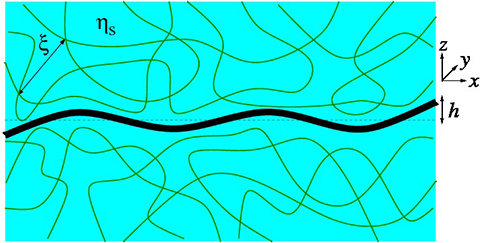EPJ E Highlight - Unexpected undulations in biological membranes
- Details
- Published on 09 January 2018

Study of the dynamic properties of biological membranes reveals new anomalous behaviour under specific circumstances
How biological membranes - such as the plasma membrane of animal cells or the inner membrane of bacteria - fluctuate over time is not easy to understand, partly because at the sub-cellular scale, temperature-related agitation makes the membranes fluctuate constantly; and partly because they are in contact with complex media, such as the cells’ structuring element, the cytoskeleton, or the extra-cellular matrix. Previous experimental work described the dynamics of artificial, self-assembled polymer-membrane complexes, embedded in structured fluids. For the first time, Rony Granek from Ben-Gurion University of The Negev, and Haim Diamant from Tel Aviv University, both in Israel, propose a new theory elucidating the dynamics of such membranes when they are embedded in polymer networks. In a new study published in EPJ E, the authors demonstrate that the dynamics of membrane undulations inside such a structured medium are governed by distinctive, anomalous power laws.
The main building block of biological membranes is a flexible fluid bilayer of lipid molecules. In their model, the authors first define the coupling of the membrane with the two constituents of the surrounding fluid—namely the polymer and the solvent. The membrane surface defines the strength of the membrane-fluid coupling, which can either be weak (when the membrane is primarily in contact with the solvent) or strong (where both the solvent and network move together with the membrane).
The authors then study the consequences of the two types of coupling for the dynamics of membrane undulations. In the weak-coupling limit, where the polymer network does not move together with the membrane but is merely dragged along by the resulting solvent flow, the authors identify a new intermediate wavelength regime of the membrane undulations.
They conclude that for both flexible and semi-flexible semi-dilute polymer solutions, the statistics of membrane displacements associated with this intermediate regime may span several orders of magnitude in time, until the bulk viscoelasticity of polymers takes over.
Membrane undulations in a structured fluid: Universal dynamics at intermediate length and time scales. R. Granek and H. Diamant (2018), Eur. Phys. J. E 41: 1, DOI 10.1140/epje/i2018-11607-x





